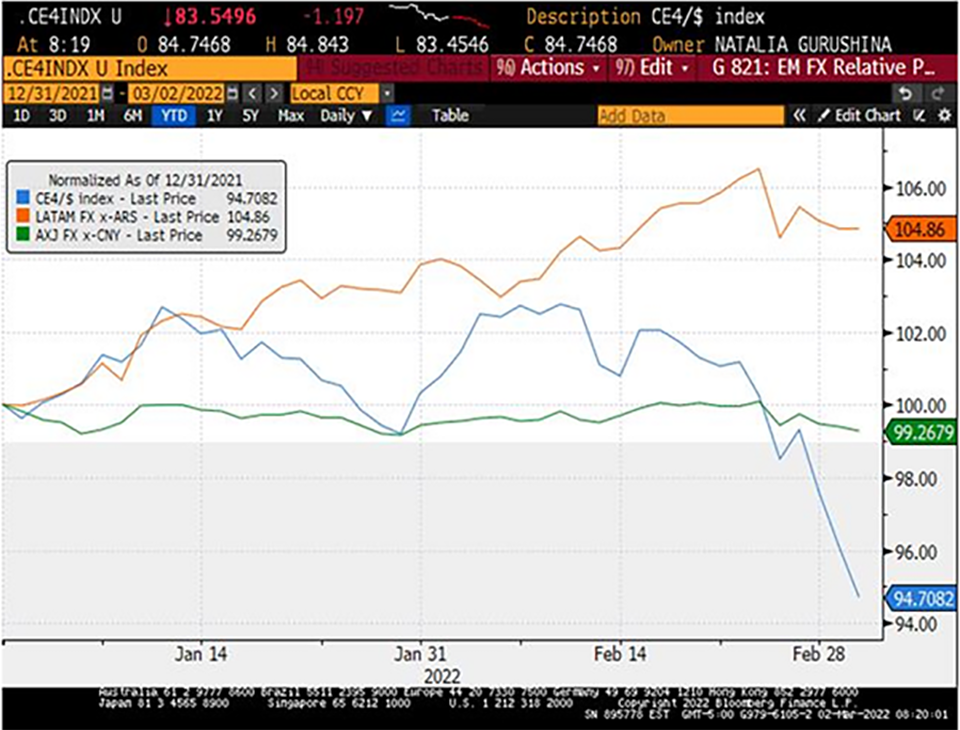The Russia/Ukraine war poses additional challenges for European economies, which are now facing higher inflation risks and more growth headwinds.
Russia/Ukraine War, Consequences
Russia continued its military offensive in Ukraine, despite chatter about another round of talks between the two sides. The Russian currency and depositary receipts are doing poorly this morning. Ukraine’s sovereign debt was also under pressure – the fact that Ukraine made a scheduled payment on its 2022 sovereign bond yesterday was noted, but made no market impact due to fat negative tail risks. Concerns about the global fallout are multiplying. However, the U.S. Federal Reserve Chair Jerome Powell said in his yesterday’s testimony to the House that the March rate hike is still on the table. As of this morning, the Fed Funds Futures price in 26-27bps in March, and a total of 5 rate hikes in 2022.
Europe Growth, Inflation Risks
As regards other major central banks, higher inflation pressures (via food and commodity prices) and more growth headwinds pose additional policy challenges – especially in Europe/Central Europe. Sell-side economists have already started to cut their 2022 growth forecasts for the region. Right now, the revisions are modest – about 1% or so – but if military operations last longer and affect more territory, we should expect sharper growth downgrades. A prospect of wider budget deficits and worsening debt metrics – against the backdrop of large-scale refugee inflows – further complicates the picture. The chart below shows that Central European currencies underperformed emerging markets (EM) peers by a wide margin so far this year, as did local currency debt. Persisting currency weakness can increase pressure on regional central banks to hike more – this scenario is now reflected in the market rate expectations for 6 months. An alternative is to step up interventions on the FX market – this option was used today by Poland’s central bank.
Low-Income Countries Debt Relief
The final point we would like to make today is the potential negative impact on lower-income countries, some of which can be hit by the triple-whammy of higher commodity prices, trade disruptions (wheat importers from Ukraine), and lower foreign direct investments/loans from Russia. Would the debt relief initiative for lower-income countries – which was put in place during the pandemic – have to be revisited in the coming weeks? Stay tuned!

Originally published by VanEck on March 2, 2022.
For more news, information, and strategy, visit the Beyond Basic Beta Channel.
PMI – Purchasing Managers’ Index: economic indicators derived from monthly surveys of private sector companies. A reading above 50 indicates expansion, and a reading below 50 indicates contraction; ISM – Institute for Supply Management PMI: ISM releases an index based on more than 400 purchasing and supply managers surveys; both in the manufacturing and non-manufacturing industries; CPI – Consumer Price Index: an index of the variation in prices paid by typical consumers for retail goods and other items; PPI – Producer Price Index: a family of indexes that measures the average change in selling prices received by domestic producers of goods and services over time; PCE inflation – Personal Consumption Expenditures Price Index: one measure of U.S. inflation, tracking the change in prices of goods and services purchased by consumers throughout the economy; MSCI – Morgan Stanley Capital International: an American provider of equity, fixed income, hedge fund stock market indexes, and equity portfolio analysis tools; VIX – CBOE Volatility Index: an index created by the Chicago Board Options Exchange (CBOE), which shows the market’s expectation of 30-day volatility. It is constructed using the implied volatilities on S&P 500 index options.; GBI-EM – JP Morgan’s Government Bond Index – Emerging Markets: comprehensive emerging market debt benchmarks that track local currency bonds issued by Emerging market governments; EMBI – JP Morgan’s Emerging Market Bond Index: JP Morgan’s index of dollar-denominated sovereign bonds issued by a selection of emerging market countries; EMBIG – JP Morgan’s Emerging Market Bond Index Global: tracks total returns for traded external debt instruments in emerging markets.
The information presented does not involve the rendering of personalized investment, financial, legal, or tax advice. This is not an offer to buy or sell, or a solicitation of any offer to buy or sell any of the securities mentioned herein. Certain statements contained herein may constitute projections, forecasts and other forward looking statements, which do not reflect actual results. Certain information may be provided by third-party sources and, although believed to be reliable, it has not been independently verified and its accuracy or completeness cannot be guaranteed. Any opinions, projections, forecasts, and forward-looking statements presented herein are valid as the date of this communication and are subject to change. The information herein represents the opinion of the author(s), but not necessarily those of VanEck.
Investing in international markets carries risks such as currency fluctuation, regulatory risks, economic and political instability. Emerging markets involve heightened risks related to the same factors as well as increased volatility, lower trading volume, and less liquidity. Emerging markets can have greater custodial and operational risks, and less developed legal and accounting systems than developed markets.
All investing is subject to risk, including the possible loss of the money you invest. As with any investment strategy, there is no guarantee that investment objectives will be met and investors may lose money. Diversification does not ensure a profit or protect against a loss in a declining market. Past performance is no guarantee of future performance.

